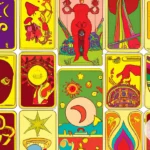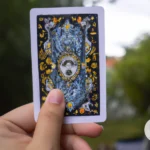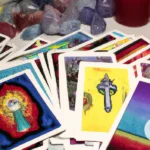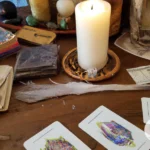As the world becomes more diverse, it’s important to acknowledge and appreciate different cultures. Tarot cards have been used for centuries as a tool for self-reflection, spiritual guidance, and divination. But did you know that tarot can also be used for social justice and self-care? Incorporating multicultural tarot decks in your practice can help you become more aware of cultural differences and promote inclusivity. In this article, we’ll explore the role of tarot in social justice and self-care, the benefits of using multicultural tarot decks, and how to incorporate them in your readings. Let’s dive in!
Understanding Tarot for Social Justice and Self-Care
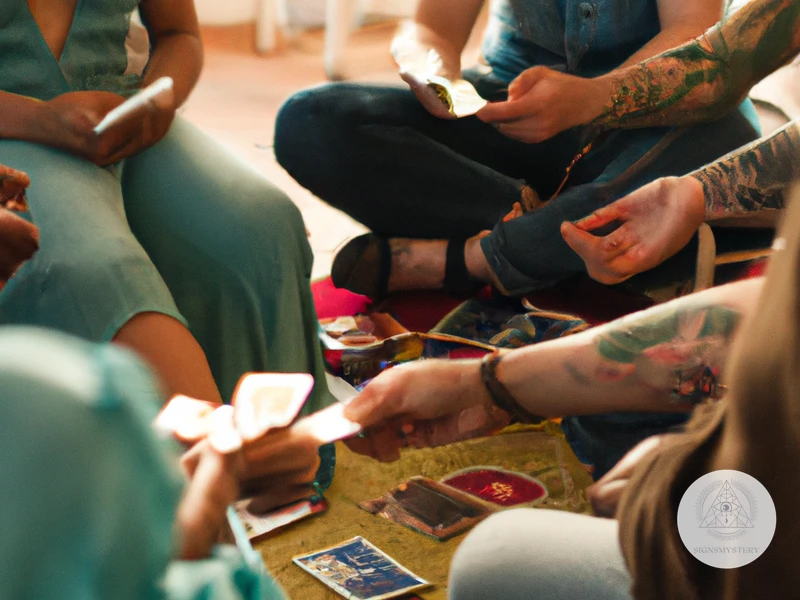
As tarot decks have become more inclusive and diverse, their use has expanded beyond just divination. Many individuals and communities are using tarot for both social justice and self-care purposes. Understanding the intersection of tarot and these important areas can deepen our connection to the practice and expand its meaning. While tarot can be a personal tool for introspection, it can also be used to inform and empower our actions in the wider world. In this section, we will explore both the role of tarot in social justice and how it can aid in self-care. For more information on multicultural tarot decks and their significance, refer to our previous article “Exploring Multicultural Tarot Decks.”
The Role of Tarot in Social Justice
The utilization of Tarot for social justice is a relatively newer concept, but one that holds great promise for those looking to effect change in the world. Tarot is a divination tool that has been used for centuries to gain insight into our lives and the world around us. It is based on archetypes and symbolism, which can be interpreted in a myriad of ways. In recent years, Tarot has gained popularity as a tool for personal growth, introspection, and self-care, and has been increasingly used to address social justice issues.
So how can Tarot be used for social justice? One way is by using it to explore systems of oppression and privilege. Tarot can help us identify the ways in which these systems operate in our lives and the world around us. By doing so, we can begin to understand and challenge these systems and work towards a more just and equitable world.
Another way Tarot can be used for social justice is by using it to develop empathy and compassion for others. Tarot can help us connect with people from different backgrounds and experiences, and can help us understand their perspectives. By doing so, we can better advocate for and support marginalized communities.
Tarot can also be used as a tool for envisioning a more just and equitable future. By exploring the possibilities and potentials of different paths and outcomes, Tarot can help us identify the steps we need to take to achieve our goals.
Ultimately, Tarot can be used for social justice by empowering individuals and communities to effect change in their lives and the world around them. By providing insight, guidance, and support, Tarot can help us create a world that is more just, equitable, and compassionate for all.
If you want to learn more about how to use Tarot for social justice and self-care, check out our article on Using Multicultural Tarot Decks for Social Justice and Self-Care. There, you can also learn about the history and significance of multicultural Tarot decks, and discover our top picks for multicultural Tarot decks to incorporate into your practice.
How Tarot Helps with Self-Care
Tarot can be so much more than just a tool for divination – it can also be a powerful tool for self-care. Here are some ways that tarot can help with self-care:
- Self-reflection: When we’re feeling overwhelmed or stressed, it can be easy to let our thoughts spiral into negative patterns. Tarot can provide a structured way to reflect on our emotions and thought patterns in a more objective way. By laying out the cards and examining the symbols and themes present, we can gain insight into our own experiences and feelings.
- Mindfulness: Tarot can be a meditative practice that encourages us to be present in the moment. By focusing on the images and symbols in the cards, we can practice mindfulness and become more aware of our thoughts and emotions without becoming overwhelmed by them.
- Empowerment: Sometimes when we’re feeling down or disempowered, it can be helpful to focus on our strengths and sources of power. Tarot can be a way to connect with our inner strength and intuition, and it can help us to feel more confident and self-assured.
- Problem-solving: Tarot can be a powerful tool for problem-solving. By asking focused questions and drawing cards to answer them, we can gain insights into complex issues and come up with creative solutions.
- Self-care planning: We often talk about the importance of self-care, but it can be hard to know where to start. Tarot can be a way to brainstorm self-care ideas and develop a plan that is tailored to our individual needs and preferences.
Of course, it’s important to note that tarot is not a substitute for professional medical or psychological care. However, it can be a valuable addition to a self-care routine and can provide insights and guidance that may not be accessible through other means.
Choosing Multicultural Tarot Decks
When it comes to choosing the right tarot deck for social justice and self-care, there are a wide variety of options to consider. In particular, looking for decks that represent diverse cultures and backgrounds can help expand your perspective and provide a more comprehensive approach to tarot readings. However, with so many different multicultural tarot decks available, it can be challenging to know where to start. In this section, we will explore what constitutes a multicultural tarot deck, the benefits of using them, and highlight some examples to help guide your decision-making process.
What is a Multicultural Tarot Deck?
A Multicultural Tarot Deck is a tarot deck that features diverse cultural representation and includes symbols, motifs, and artwork from different cultures, rather than just relying on traditional Western imagery. These decks are becoming increasingly popular as more people seek to incorporate diversity and inclusivity into their spiritual practices.
- Diverse representation: Multicultural tarot decks feature a diverse representation of cultures and people, including symbols, imagery, and folklore from around the world.
- Inclusivity: These decks promote inclusivity by depicting a variety of races, genders, and sexual orientations, which can help to bridge the gap between different communities and encourage empathy and understanding.
- Cultural sensitivity: Multicultural tarot decks are created with cultural sensitivity in mind and are respectful towards the cultures they represent.
- Universality: While multicultural tarot decks may feature specific cultural traditions, they can still be interpreted in a universal context, making them accessible to people of different cultures and backgrounds.
A Multicultural Tarot Deck is a tool that can help promote cultural awareness and understanding, encourage empathy and compassion, and expand our understanding of the world around us.
Benefits of Using Multicultural Tarot Decks
When it comes to tarot decks, diversity matters. Using multicultural tarot decks has many benefits, including:
- Representation: Multicultural tarot decks provide representation for underrepresented cultures and communities in the tarot world. This can be empowering and validating for those who may have felt excluded or marginalized by traditional tarot decks.
- Cultural Connection: Using tarot decks that incorporate cultural symbolism and imagery can deepen a person’s cultural connection and understanding. It can also provide an opportunity for cultural exchange and learning.
- Expanding Interpretations: Multicultural tarot decks offer a wider range of interpretations and perspectives. This can help break down biases and assumptions, leading to a more nuanced understanding of the cards and their meanings.
- Social Justice: Incorporating multicultural tarot decks promotes social justice and equity by acknowledging and honoring the contributions and experiences of diverse cultures and communities.
- Self-Care: Using tarot decks that incorporate diverse perspectives and experiences can also be beneficial for personal growth and self-care. It can help individuals explore different parts of themselves and gain new insights into their experiences.
By using multicultural tarot decks, individuals can access a richer and more inclusive world of tarot. It allows for a deeper understanding of both oneself and the world around us, promoting growth and empathy.
Examples of Multicultural Tarot Decks
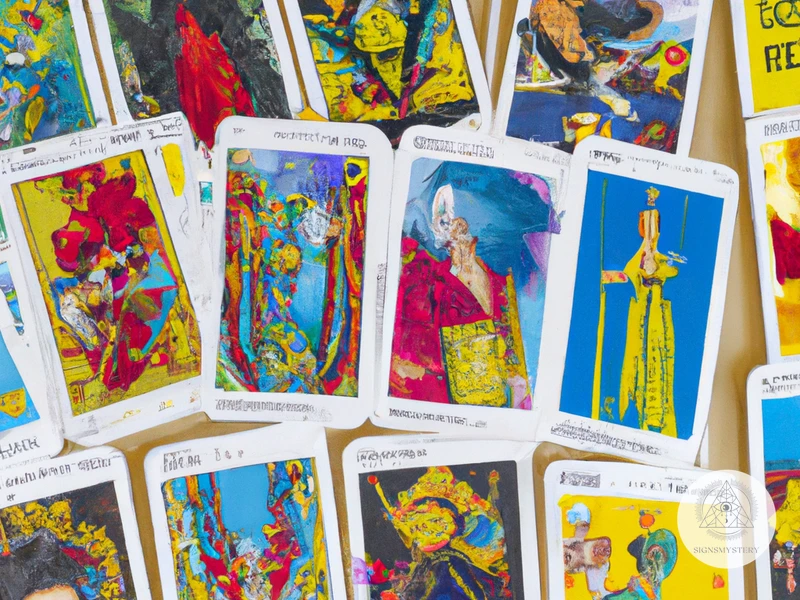
If you’re interested in exploring the world of multicultural tarot decks, you may be wondering where to start. With so many options available, the process of choosing a deck can be overwhelming. But fear not, as we’ve compiled a list of standout decks that cater to diverse perspectives and cultural backgrounds. These decks offer a unique lens through which to explore the symbolism and meanings of the tarot, providing a new level of insight and depth to your readings. Let’s take a closer look at some of the multicultural tarot decks available on the market today.
Tarot of the Divine
One of the multicultural tarot decks that stands out is the “Tarot of the Divine”. This deck, created by Yoshi Yoshitani, is based on different mythologies from around the world. The artwork is stunning and captures the essence of each mythology perfectly.
One of the standout features of this deck is the diversity of the characters depicted. There are people of different races and gender identities throughout the deck. The characters in the Major Arcana are particularly interesting, as they are not based on the traditional tarot archetypes. Instead, they are inspired by figures from mythology, such as the Hindu goddess Kali and the Japanese yokai Tengu.
The Minor Arcana cards of the “Tarot of the Divine” also incorporate multiculturalism. Each suit (Wands, Cups, Swords, and Pentacles) is based on a different mythology from around the world. For example, the Swords suit is based on Greek mythology, while the Pentacles suit is based on African mythology.
In addition to the beautiful artwork and multiculturalism, the “Tarot of the Divine” deck also has a guidebook that provides detailed information about the mythology behind each card. This can be incredibly helpful for people who are not familiar with the various mythologies represented in the deck.
The “Tarot of the Divine” is a fantastic option for anyone looking to incorporate multiculturalism into their tarot practice. The artwork is breathtaking, the characters are diverse, and the guidebook provides valuable context and information.
Afro Tarot
One multicultural tarot deck that is gaining popularity in recent years is the Afro Tarot. This vibrant deck was created by artist and writer Jessi Jumanji, who wanted to create a deck that celebrated African-American culture and history. The Afro Tarot features bright, bold illustrations that incorporate African symbols and elements of traditional tarot.
One of the standout cards in the Afro Tarot is the Chariot, which depicts a Black woman riding a bike with a basket of flowers. Jumanji explains that she chose this image as a nod to Black women who have historically used bicycles as a means of transportation and as a symbol of freedom. The Strength card features an image of a Black woman with dreadlocks holding a lion, which is a powerful symbol in many African cultures.
Jumanji has also included some new cards in the Afro Tarot that are not traditionally found in the tarot deck. For example, the Orishas card represents the deities of the Yoruba religion, which originated in West Africa and is still practiced by many African Americans today.
The Afro Tarot is a unique and powerful deck that celebrates Black culture and history. Its colorful illustrations and thought-provoking imagery make it a great choice for anyone looking to incorporate more diversity and representation in their tarot practice.
Next World Tarot
Next World Tarot is a unique and powerful multicultural tarot deck that’s worth mentioning in detail. It was created by artist and activist Cristy C. Road with the intention of representing a diverse and inclusive world.
This deck features stunning illustrations that showcase characters of different genders, races, and sexual orientations. The themes of the cards are relevant to social justice issues and touch upon topics such as Islamophobia, police brutality, and environmental destruction.
One of the standout features of Next World Tarot is its inclusivity. The deck doesn’t shy away from representing individuals who are typically marginalized in tarot, such as people with disabilities and non-binary folks. It does so in a way that’s both beautiful and empowering.
Another noteworthy aspect of this deck is its attention to detail. The symbolism in each card is rich and complex, making it perfect for those who appreciate a deck that requires a closer examination.
Below is a table summarizing some of the key features of Next World Tarot:
| Artist | Cristy C. Road |
| Number of Cards | 78 |
| Diversity | Yes (features people of different races, genders, sexual orientations, and abilities) |
| Themes | Social Justice, Environmentalism, Radical Politics |
| Symbolism | Rich and Complex |
Incorporating Next World Tarot into your readings can be a powerful way to center social justice and inclusivity. It’s important to approach this deck with a level of cultural sensitivity and to take the time to learn the context and symbolism of each card. However, the effort put into understanding this unique and impactful deck is well worth it.
The Visionary Tarot
The Visionary Tarot is a multicultural tarot deck that features stunning artwork by author and artist, Paris-based Caroline Smith. This deck was created with the intention to foster deeper connections with the natural world, the divine, and the human spirit.
One of the standout features of The Visionary Tarot is the diversity of cultural influences that inform the deck’s imagery. Smith draws on ancient cultures and spiritual traditions from around the world, including Egypt, Japan, Tibet, and Native American cultures. Each card showcases a fusion of these different cultural elements, creating a rich tapestry of symbolism.
One example of this can be seen in the deck’s version of the Empress card. In this depiction, the Empress is a Black woman in a flowing white gown. She sits on a throne decorated with intricate Egyptian carvings, surrounded by the lush greenery of a tropical jungle. The card’s message is clear: the feminine energy of nurturing and creation can be found in a variety of cultures and traditions.
Another standout feature of The Visionary Tarot is its attention to detail. Every card in the deck is meticulously crafted, with each symbol and color choice serving a specific purpose. For example, the Knight of Swords is depicted as a fierce warrior on a black horse, charging towards the viewer. His sword is raised high, ready to strike. This card suggests action, movement, and the need to cut through obstacles, all feelings that are conveyed through the carefully chosen imagery.
The Visionary Tarot is a beautiful and culturally rich deck that can offer valuable insights into both personal and social issues. Its attention to detail and diverse influences make it a valuable addition to any tarot collection. Strongly recommended for those who are looking for a deck that offers a unique blend of cultures and traditions.
| Deck Name | The Visionary Tarot |
| Author/Artist | Caroline Smith |
| Cultural Influences | Egypt, Japan, Tibet, Native American and more |
| Features | Diversity of cultural influences, attention to detail, and unique symbolism |
| Overall Impression | Beautiful, culturally rich deck that offers unique perspectives on personal and social issues |
And More!
Multicultural tarot decks have gained popularity in recent years, and with good reason. These decks offer a diverse range of perspectives and symbolism that are not represented in traditional tarot decks. In addition to Tarot of the Divine,
Subscribe to Our Newsletter
Sign up to receive the latest news and updates.
- Hoodoo Tarot: This deck combines elements of African American culture and spirituality with traditional tarot imagery.
- Your Tarot Your Way: A customizable deck that allows users to create their own cards based on their personal experiences and identities.
- Mahjong Oracle and Tarot: A fusion of Asian and Western cultures, with tarot cards and mahjong tiles used for divination.
- Native American Tarot: This deck uses Native American symbolism and storytelling to provide spiritual guidance and insight.
- Mystical Manga Tarot: A fusion of Japanese manga and tarot, this deck offers a new interpretation of traditional tarot symbols.
These decks offer unique perspectives that can enhance your tarot practice, and they demonstrate the rich diversity of cultures and traditions that exist in our world today. When choosing a multicultural tarot deck, take the time to research the deck’s origins and symbolism to ensure that it aligns with your own values and intentions. By incorporating diverse perspectives into your tarot practice, you can deepen your understanding of the world and promote social justice and inclusivity.
How to Incorporate Multicultural Tarot Decks in Your Readings
As you begin to incorporate multicultural tarot decks into your readings, you may have questions about how to approach this new practice. It’s important to be intentional, culturally sensitive, and knowledgeable about the context and symbolism of the deck you are using. In this section, we will explore some tips and techniques for incorporating multicultural tarot decks into your readings with confidence and respect.
Intention-Setting
One important aspect of incorporating multicultural tarot decks into your readings is setting a clear intention. This allows you to focus on the specific issue or situation you want guidance on. Intention-setting is a powerful tool in tarot readings because it helps to create a space for deep reflection and self-exploration.
To set your intentions, consider the question or issue you want to explore in your tarot reading. Write it down on a piece of paper or use a note-taking app to keep track of it. Once you have your question or issue in mind, take some time to reflect on it.
Think about what you hope to gain from the reading, and what aspects of the issue you want to focus on. This will help you to formulate a clear intention for your reading. It’s important to remember that your intention doesn’t have to be a specific outcome or answer. Instead, it can be a more open-ended exploration of the issue at hand.
Once you have your intention in mind, take a few deep breaths and focus your energy on your question or issue. You may want to visualize the intention as a bright light or imagine yourself opening up to the guidance of the tarot.
Setting a clear intention helps to create a container for your reading, and allows you to stay present and focused throughout the process. It’s also helpful to revisit your intention throughout the reading, especially if you find yourself getting distracted or losing focus.
To keep track of your intention, you can write it down on a slip of paper and place it near your tarot deck while you shuffle the cards. Alternatively, you can keep it in mind or repeat it to yourself silently as you lay out the cards for the reading.
Intention-setting is an important practice to incorporate into your tarot readings, especially when using multicultural decks. By setting a clear intention, you can create a focused and grounded space for your exploration, and allow the guidance of the tarot to unfold in a meaningful and powerful way.
| Key Points | Explanation |
| Intention-setting | The process of creating a clear focus for your tarot reading |
| Question or issue | The central topic or problem that you want guidance on |
| Reflect | To think deeply about your question or issue |
| Breathwork | The practice of using your breath to cultivate focus and relaxation |
| Outcome or answer | A specific result or response to your question |
| Open-ended exploration | The process of exploring an issue without a specific outcome in mind |
| Container | A metaphorical container that holds your intention and keeps your focus grounded and present |
Cultural Sensitivity
When using multicultural tarot decks, it is essential to approach the readings with cultural sensitivity. This means being aware of and respectful towards different cultures and avoiding any cultural appropriation or stereotypes.
To begin with, it is crucial to understand the cultural significance and symbolism behind the tarot decks being used. Each culture has its own unique interpretation and representation of tarot cards, and it is essential to consider this when using a multicultural tarot deck.
Additionally, it is important to acknowledge and respect the origins and history of the different cultures incorporated in the tarot deck. A basic understanding of cultural history and traditional practices can prevent any unintentional cultural insensitivity or offense.
When interpreting the cards, it is important to use inclusive language and avoid making assumptions based on cultural stereotypes. Take the time to understand the context and meaning behind the symbols present in the cards to prevent any misinterpretations.
It is crucial to approach the reading with an open mind and avoid projecting personal biases or assumptions onto the cards. This means being aware of our own identities, privileges, and biases and acknowledging how they may influence our interpretation of the cards.
Cultural sensitivity is a critical aspect to consider when using multicultural tarot decks as it ensures that readings are respectful, inclusive, and accurate representations of the cultures depicted in the deck. By approaching the cards with cultural sensitivity, we can create a safe and empowering space for all individuals to receive guidance and insight through the power of tarot.
Learning Context and Symbolism
When working with multicultural tarot decks, it’s important to take the time to learn about the context and symbolism of the specific cultures represented in the deck. This adds depth and richness to your readings, and also shows respect for these cultures.
Context refers to the historical, social, and political background of a particular cultural group. When using a multicultural tarot deck, take the time to research the history and current issues facing the culture represented in the deck. This will allow you to better understand the context in which the symbolism is used and will help you to interpret the cards more accurately.
Symbolism is a key element of tarot readings, and each culture has its own set of symbols that have specific meanings. When using a multicultural deck, it’s important to take the time to research the symbols used in the deck that are specific to the cultures represented. This will help you to interpret the cards in a more nuanced way and will add depth to your readings.
One way to organize your research is by creating a table that lists the symbols and their meanings in each culture represented in the deck. For example, if you’re using the Afro Tarot deck, your table might look something like this:
| Culture | Symbol | Meaning |
|---|---|---|
| Yoruba | Orisha | Divine messenger |
| West African | Adinkra symbols | Moral values and cultural concepts |
| Haitian | Vodou symbols | Deities and elements of nature |
By taking the time to research the context and symbolism of the cultures represented in your multicultural tarot deck, you’ll be better equipped to provide accurate and respectful readings that honor the traditions and beliefs of these cultures.
Conclusion
In conclusion, using multicultural tarot decks can be a powerful tool for both social justice and self-care. The tarot has historically been used as a means of divination, but it has also been used as a tool for personal growth and empowerment. By incorporating multicultural tarot decks into our practice, we can broaden our understanding of different cultures, challenge our biases, and gain new perspectives.
Multicultural tarot decks can also help us with self-care by providing a means of introspection and reflection. Engaging with diverse decks can be a way to connect with our own heritage, as well as learn about cultures other than our own. This exploration can help us to develop a deeper self-awareness, cultivate empathy and understanding for others, and foster a sense of community.
When choosing a multicultural tarot deck, it is important to consider the deck’s cultural context and symbolism. It is essential to approach these decks with cultural sensitivity and respect, as well as a willingness to learn and grow. Additionally, setting an intention before the reading can help us to focus our energy on what we want to learn and achieve from the session.
Some examples of multicultural tarot decks include Tarot of the Divine, Afro Tarot, Next World Tarot, and The Visionary Tarot, among others. Each deck has its own unique imagery and message, providing a plethora of options to meet your specific needs and interests.
Overall, using multicultural tarot decks can be a transformative practice for social justice and self-care. By expanding our worldview and connecting with diverse perspectives, we can create a more just and compassionate world for ourselves and others.
Frequently Asked Questions
What is the origin of Tarot cards?
Tarot cards originated in Italy in the 15th century as a deck of playing cards called Tarocchi, and later evolved into a tool for divination and spiritual introspection.
How can Tarot cards be used for social justice?
Tarot cards can be used to explore issues of equity, diversity, and inclusion, and to provide insight and guidance on how to create more just and equitable systems.
Can anyone use Tarot cards for self-care?
Yes, Tarot cards can be a helpful tool for anyone looking to gain clarity, insight, and guidance on their personal growth journey.
What is a multicultural Tarot deck?
A multicultural Tarot deck is a deck that incorporates diverse cultural perspectives and represents a variety of racial and ethnic identities in its imagery and symbolism.
Why is using a multicultural Tarot deck important for social justice?
Using a multicultural Tarot deck can help to promote diversity, equity, and inclusion in the spiritual community, and can provide a more inclusive and representative practice for people of all backgrounds.
What are some benefits of using a multicultural Tarot deck?
Some benefits of using a multicultural Tarot deck include a greater sense of cultural awareness and sensitivity, a deeper connection to diverse spiritual traditions, and a more inclusive and representative practice.
What is the Tarot of the Divine?
The Tarot of the Divine is a multicultural Tarot deck that incorporates diverse cultural perspectives and celebrates the divine in all its forms.
What is the Afro Tarot?
The Afro Tarot is a multicultural Tarot deck created by artist and healer Jessi Huntenburg that celebrates the power and beauty of the African diaspora.
What is the Next World Tarot?
The Next World Tarot is a multicultural Tarot deck created by artist and activist Cristy C. Road that uses a punk rock aesthetic to explore themes of justice, resistance, and community building.
How can I be culturally sensitive when using a multicultural Tarot deck?
To be culturally sensitive when using a multicultural Tarot deck, it’s important to approach it with an open mind and a willingness to learn, to respect the cultural origins and symbolism of the imagery, and to be mindful of any cultural appropriation or fetishization.



